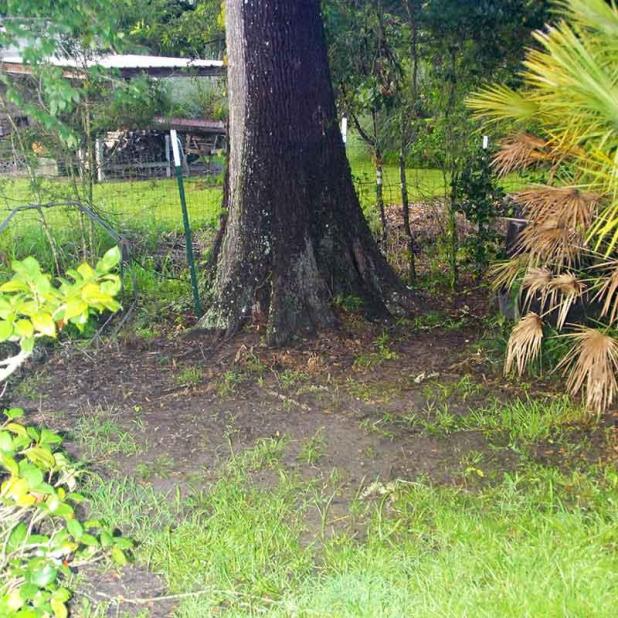
LSU AgCenter Horticulturist Dan Gill suggests planting shade-tolerant perennials or ground covers where grass will not grow.
—LSU AgCenter/Rick Bogren
Get It Growing: Too much shade means lawn problems
Often, the things people plant first in new landscapes are the lawn and shade trees. As time goes on, however, sun-loving lawn grasses and shade trees don’t go together particularly well.
Shade trees grow up to do exactly what they were planted to do — create shade. Eventually, areas where grass had always grown well will no longer get enough sun. Bare areas under and around trees occur because conditions are too shady for grass to thrive there. If you are trying to deal with this sort of situation, here are some things you can do.
You can increase the amount of sunlight reaching the turf by selectively pruning trees in the landscape. The lower branches and some of the inner branches may be removed to allow more light to reach the lawn below. Raising and thinning the canopy on older, mature trees is best done by a professional arborist who can determine which branches should be removed without adversely affecting the tree.
After this is done, the existing grass will hopefully do better. If the grass has died out in the area, you can lay new sod. Remember, the tree will continue to grow, and this should be considered, at best, a temporary solution.
St. Augustine is considered the most shade-tolerant grass for our area and should be tried if shade is an issue. Understand that the word tolerance does not mean that this grass thrives in the shade. All our lawn grasses prefer full sun; it’s just that St. Augustine will do better than the others with some shade during the day.
Rye grasses and fescues will grow quite well in shady areas during our cool season, but they must be replanted every fall as the heat kills them in May. During summer, areas where these cool season grasses were growing are bare.
Grass growing in shaded areas should be mowed at a slightly higher setting on your lawn mower than normally recommended. This allows the leaf blades to grow longer and therefore have more surface area to absorb what light is available and produce food through photosynthesis. St. Augustine can be mowed at a height of 4 inches. Grass growing under trees needs less fertilizer because it grows slower, but it may need more irrigation as the tree roots compete with the grass for water.
If after these efforts you still can’t get grass to grow under your tree, it’s time to accept the situation and stop wasting your time and money trying to make grass grow where it can’t. Unless cutting down the tree is an option, you have two choices: cover the area with a few inches of mulch, or look at the area as an outstanding opportunity to create a new garden with shade-loving plants.
Trees love a layer of mulch over their roots, and this is the best solution as far as the tree is concerned. The mulch should be about 4 inches thick. Feel free to use the leaves the trees drop in the fall to mulch shady areas under their canopies. You can also purchase mulches based on what look you prefer.
The most important thing to remember when creating landscaped areas under a tree is to respect the root system of the tree itself. Avoid severing any roots larger than 1 inch in diameter. Because bare soil areas often become compacted over time, turn the soil with a garden fork rather than with a shoved or spade because the fork will damage fewer roots.
If you need to bring in extra soil to create the bed, choose a garden soil mix high in organic matter and spread no more than about 4 inches deep. Do not pile several inches of soil around the base of a tree trunk because this can lead to decay. If you intend to fill in an area that will cover a large part of the tree’s root system, do not apply more than 2 inches of fill.
The simplest solution to addressing bare spots is to plant the area entirely with a low-growing ground cover. The three best ground covers for large areas are monkey grass (Ophiopogon japonicus), creeping lily turf (Liriope spicata) and Asian jasmine (Trachelospermum asiaticum). These ground covers are reliable, easy to grow and relatively fast spreading.
Other ground covers suitable for larger areas include ferns, such as holly fern, autumn fern, wood fern and many others, English ivy, Japanese ardisia, liriope (Liriope muscari), Algerian ivy and the asparagus fern (Asparagus sprengeri).
Many other plants thrive in partially shaded to shady conditions.
For colorful bedding plants, try impatiens, wax begonias, caladiums and torenias.
Shade-tolerant perennials include ferns, hostas, ground orchid, strawberry begonia, indigo, ligularia, aspidistra, purple heart, ajuga, cardinal flower, Indian pinks, violets and the many gingers.
Shrubs to consider include hollies, azaleas, nandinas, cleyera, sago, hydrangea, ligustrum, aucuba, fatsia, mahonia, pittosporum, hydrangea, mahonia, red buckeye, sasanqua, camellia and Christmas berry (Ardisia crispa).
When the lawn grass finally decides that an area has become too shady for it to grow there anymore, don’t fight it. Instead, open yourself to the wonderful possibilities of planting a beautiful and satisfying garden of shade-loving plants.
